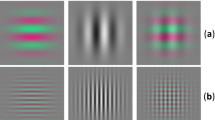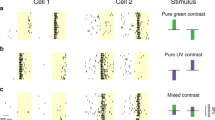Summary
De Lange has found that with alternation of coloured stimuli sometimes a subjective luminance variation exists, even when the luminances of the stimuli are equal. One can avoid this luminance flicker by changing the phase between the stimuli. This is thought to be a compensation for a phase shift between the responses to these stimuli somewhere in the retinocortical system.
These phase shifts are measured for a number of wavelength combinations ranging from 460 to 675 nm with intervals of some 20 nm at a retinal illumination of 2 trolands and with a 2° field. The phase angles turn out to be approximately additive.
De Lange's suggestion to interpret these phase shifts in terms of more basic phaseshifts between the responses of the fundamental colour mediating systems has been worked out. An interpretration is given in terms of the Young-Helmholtz theory of colour vision. Second order non-linear effects cause small distortions of this simple model.
The possible influence of the phase shift on the determination of the luminosity curve with heterochromatic flicker is discussed.
Résumé
Les recherches de de Lange ont démontré qu'on peut voir quelquefois un changement de la luminance subjective en regardant l'alternative des stimulus colorés, bienque les luminances des stimulus fussent pareilles. Un déphasage entre les stimulus peut effectuer l'impression que les papillotages ont disparu. On peut s'imaginer ce décalage de phase comme une compensation pour le décalage entre les réponses de ces stimulus quelque part dans le système rétino cortical.
Ces déphasages ont été mesurés pour une série de combinaisons de longueur d'onde dans la région de 460–675 nm pour tous les intervalles d'environ 20 nm, une illumination de la rétine de 2 trolands et un champ visuel de 2°.
Les expériments indiquent qu'on peut additionner approximativement les angles de phase.
La suggestion de de Lange d'interpréter ces déphasages comme des déphasages entre les réponses des systèmes chromatiques fondamentaux a été élaborée aux termes de la théorie Young-Helmholtz de la vision des couleurs.
Les effets non-linéaires du deuxième ordre causent de petites déviations de ce modèle simple.
L'influence possible de ces décalages de phase par des papillotages hétérochromatiques sur la détermination de la courbe de la sensibilité de l'oeil a été discutée.
Zusammenfassung
De Lange hat gefunden, dass bei Abwechslungen farbiger Reize eine subjektive Luminanz-Variation entstehen kann, selbst wenn die Luminanzen der beiden Reize gleich waren. Eine Änderung der Phase zwischen den Reizen ist nötig, um einen flimmerfreien Eindruck zu bekommen. Diese Phasenverschiebung kann man sich als eine Kompensation denken für eine Phasenverschiebung zwischen den Antworten dieser Reize in dem retinokortikalen System.
Diese Phasenverschiebungen wurden gemessen für eine Reihe von Wellenlängen-Kombinationen von 460 bis zu 675 nm mit Intervallen von ungefähr 20 nm für eine retinale Beleuchtung von 2 trolands und einem Gesichtswinkel von 2°. Diese Phasenverschiebungen zeigen sich additiv zu sein.
Die Suggestion von de Lange um diese Phasenverschiebungen zu beschreiben als Phasenverschiebungen zwischen den Antworten der fundamentalen Farbensysteme, ist ausgearbeitet worden. Für diese Interpretation ist die Farbentheorie von Young-Helmholtz benutzt worden.
Nicht-lineare Effekte zweiter Ordnung verursachen kleine Störungen in diesem einfachen Model.
Der mögliche Einfluss dieser Phasenverschiebungen auf die Feststellung der Augenempfindlichkeitskurve mit Flimmerphotometrie ist diskutiert worden.
Similar content being viewed by others
References
Benham, C. E. (1894) Artificial Spectrum Top. Nature, Lond., 51, 113–114.
De Lange Dzn, H. (1957) Attenuation Characteristics and Phase-shift Characteristics of the Human Fovea-Cortex Systems in Relation to Flicker Fusion Phenomena. Thesis Technical University of Delft.
—, (1958) Research into the Dynamic Nature of the Human Fovea-Cortex Systems With Intermittent and Modulated Light II, Phase Shift in Brightness and Delay in Color Perception. J. opt. Soc. Amer., 48, 784–789.
Pitt, F. H. G. (1944) The Nature of Normal Trichromatic and Dichromatic Vision. Proc. Roy. Soc., 132 B, 101–117.
Thomson, L. C. & Wright, W. D. (1953) The Convergence of the Tritanopic Confusion Loci and the Derivation of the Fundamental Response Functions. J. opt. Soc. Amer., 43, 890–894.
Walraven, P. L. (1962) On the Mechanisms of Colour Vision. Thesis Univ. of Utrecht. Report of the Institute for Perception IZF 1962-16.
Walraven, P. L., & Bouman, M. A. (1964) Quantum Theory of Color Discrimination of Normal Trichromats. Vision Res., (in press).
Walraven, P. L., & Leebeek, H. J. (1964) Phase Shift of Sinusoidally Alternating Colored Stimuli. J. opt. Soc. Amer., (in press).
—, —, & Bouman, M. A. (1958) Some Measurements about the Fusion Frequency of Colors. Acta Electronica, 2, 50–55.
Author information
Authors and Affiliations
Additional information
Institute for Perception RVO-TNO (Director: Prof. Dr. M. A. Bouman)
Rights and permissions
About this article
Cite this article
Walraven, P.L., Leebeek, H.J. Phase shift of alternating coloured stimuli. Doc Ophthalmol 18, 56–71 (1964). https://doi.org/10.1007/BF00160563
Issue Date:
DOI: https://doi.org/10.1007/BF00160563




